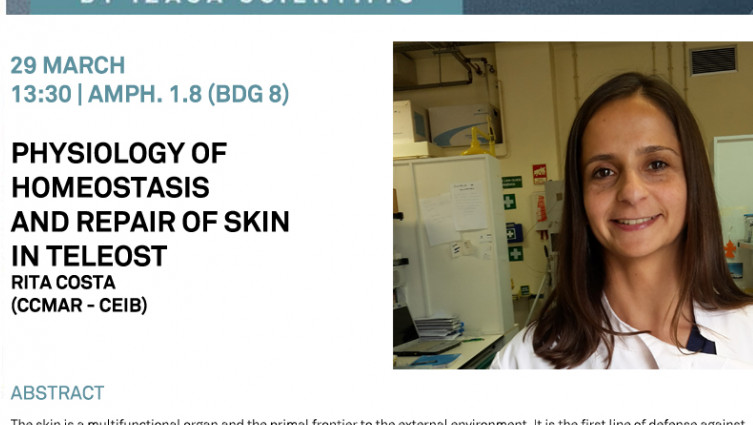CCMAR Seminars by Izasa: Physiology of homeostasis and repair of skin in teleost
CCMAR SEMINARS
29th MAR | 13:30 | Anf. 1.8 (Bdg 8)
Physiology of homeostasis and repair of skin in teleost
Rita Costa (CCMAR - CEIB)
Abstract
The skin is a multifunctional organ and the primal frontier to the external environment. It is the first line of defense against external aggressors and any injuries inflicted in the vertebrate skin are rapidly repaired to re-establish immune defense and integument homeostasis. In mammals, the outcome of skin injury is repair and scaring but in other vertebrates such as amphibians and fish regeneration of the skin occurs and the disrupted tissue is replaced by skin of the same architecture and functionality as the original. The process of skin repair in vertebrates is complex and involves a cascade of local and systemic responses to restore tissue integrity. Studies of skin in fish are of relevance for veterinary medicine, are essential for an important production sector, aquaculture and can also contribute as a biomedical model for regeneration. The aim of this study was to identify key factors involved in skin homeostasis and repair and to generate a simple model for skin repair integrating metabolic and immune considerations. The model species was the gilthead sea bream (Sparus aurata) and using morphological and gene expression analysis the processes involved in wound healing in the regenerating fish skin in response to superficial damage caused by scale removal are described.
Short CV
Rita Costa presently holds a research technician fellowship in a COFASP project at the Compared Endocrinology and Integrative Biology group at CCMAR. Rita graduated in Marine Biology and Fisheries (2005) at the University of Algarve, Faro, Portugal. She finalized her MSc in Biomedical Sciences in 2010, focusing on the study of the regeneration of sea bream skin under the influence of a metabolic stimulating compound. She recently concluded her PhD (2017) in Biomedical Sciences from the University of Algarve focusing on the detailed morphological and molecular characterization of sea bream skin regeneration. She has been involved in several national and European projects addressing the improvement of growth and quality traits in aquaculture species.


